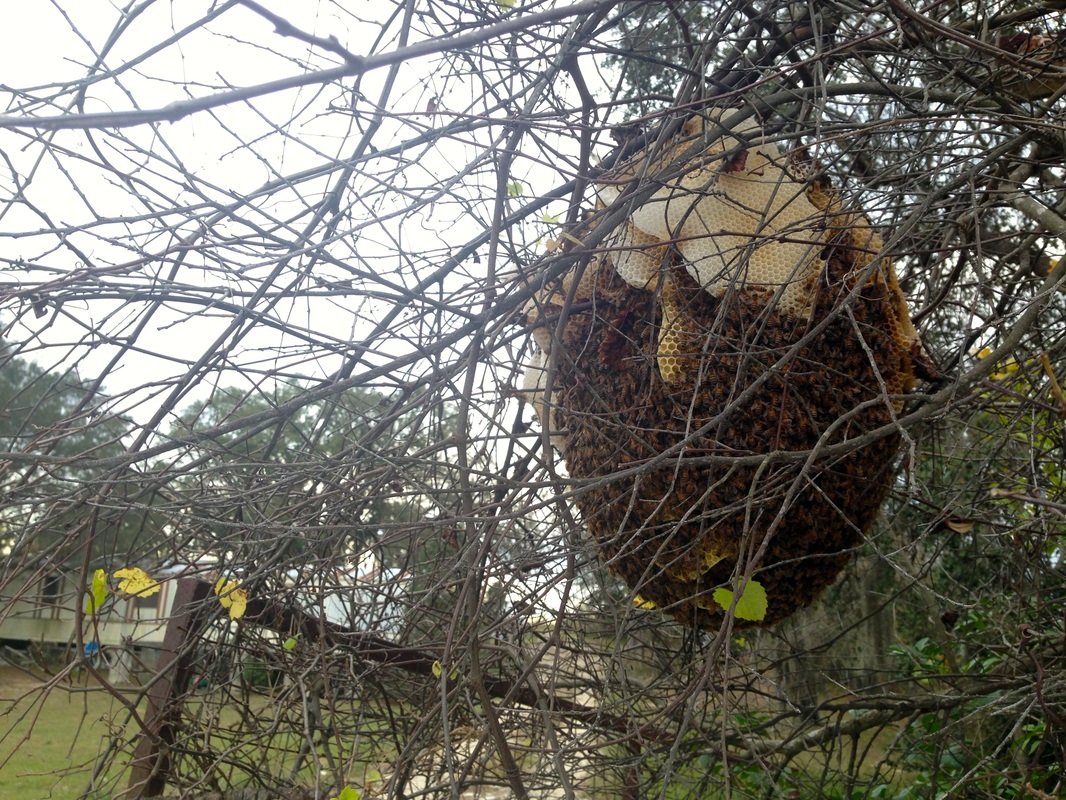|
I don't think I ever told you guys this, but back in October my bee hive was robbed by another colony, forcing my bees to take to the skies in a panic. It was a depressing day--Dave and I both loved watching the bees from our living room window, and losing the colony was like losing a beloved pet. I was pretty emo about it. Since October, I have been continuing to maintain a few hives for some neighbors while they were on holiday vacation (which meant delicious educational experience and delicious honey). The plan was to keep the colonies going strong and to split the hives in Spring, allowing me to once again host some bees in my backyard. I am very impatient. Spring seemed like a really long way off. The thoughtful and ever-adventurous Linden found out that some bees had moved into a coworker's tree--the hive had been there for awhile and grown drastically in size, and Coworker wanted the bees removed. What excellent news! Linden donned her bravest face and agreed to help me cut the hive from the tree. The hive was pretty big. Linden was super brave--she is not generally a fan of insects noisily buzzing around her head, but after a few minutes of nervous hesitation she dove right in to her new beekeeping role. While I began separating the comb from the tree, Linden arranged the removed comb into frames to be put into the hive. The very first piece of comb I examined was filled with stick eggs, larvae in various stages of development, and capped brood. Eggs turn into larvae in a matter of three days--seeing eggs indicated that the hive's queen was present in the hive at most three days ago, and it is a good sign that she is still around. She is vital to the hive's success, so we had to make sure to collect the queen. Chances of finding her majesty in a colony of tens of thousands bees are slim, but there are other ways to monitor her location. Bees stay near their leader, so by observing the actions of the colony we can keep track of the queen. As I was removing comb from the tree, the bees kept crawling higher and higher into the tree. Once all the comb was removed, suspended in frames, and placed in the hive box, Linden held a large white sheet below the hive as I shook the bees off of the tree and onto the sheet. We dumped the bees into the hive and stood back to watch. The bees tried to leave their new home and return to the ball of bees in the tree. We had not moved the queen. After a few more clumps of bees were dumped into the hive, errant bees began to collect outside the hive box and make their way inside. Bees crawled willingly down between the frames. The bee ball in the tree dispersed. All of this indicated that the queen was safe in the hive box, sending her pheromones off into the air to call her colony to her side. A spectacular sunset burned on the horizon as we worked to move the bees into their new home. After two hours of adrenaline-pumping work, everything was incased in a sticky golden envelope of honey. Linden put a finger into the comb, broke the wax, and tried the sweet nectar straight from the hive, declaring it the most delicious honey she has ever tasted. At first I attributed her announcement to the added flavors of personal investment (as a meal tastes immeasurably more delectable when prepared by your own hands than by a restaurant), but once I got home and tasted the honey for myself, Linden's statement proved itself to be true. The honey is very dark and very orange. I have no idea what is blooming right now out in Haines City, Florida, but it lends incredible zest to the bee food. With the queen and her colony safely in hive box, we taped up the hive and hit the road. Unfortunately for Dave, there were a few straggler bees that hid in our equipment and made their way into the van. Dave found himself with a few new bee friends fluttering about when he drove the car the next day. Thankfully Linden did not get stung a single time. I did not fare so well--I was wearing some super cool overalls I found at the thrift store. My bee suit rides up in the back and leaves my back exposed when I bend over, so I figured overalls would fix the problem (while also keeping me très fashionable). The downside to the overalls was that every time I reached up to cut comb from the tree my ankles were left exposed to bee fury. I was stung six times on one foot, and it swelled up pretty bad. Time to search the Salvation Army shelves for some work boots! Here are my busy bees this morning, bringing plenty of golden pollen home after foraging the neighborhood. I think they are settling in--it will be another two weeks before I open the hive for an inspection. These bees will provide wax for my encaustics, honey for my neighbors, and pollination for our community.
1 Comment
Tim
1/24/2014 08:32:28 am
Very awesome! I just learned a lot about bees. How about a heavy duty pair of socks?
Reply
Leave a Reply. |







